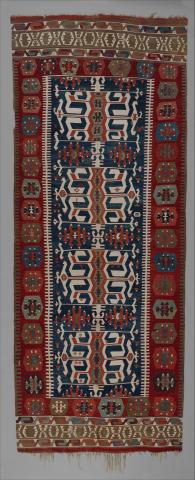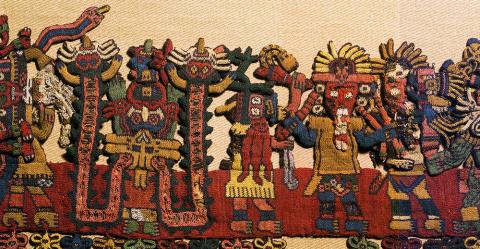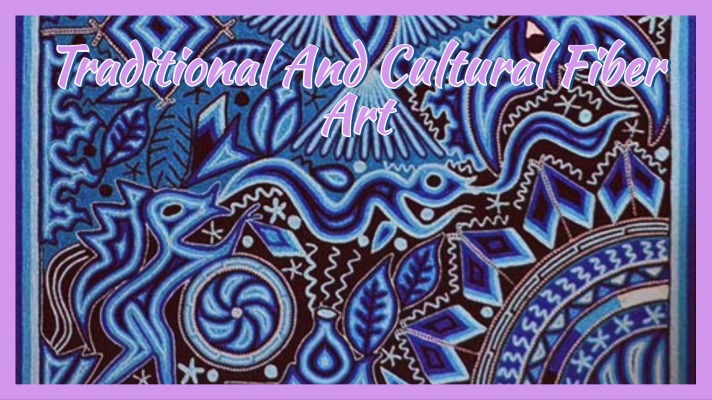For a while now, I have been researching and looking into the development of different kinds of fiber art in various cultures around the world. Each continent, country and region has their own traditions, it appears. Different societies adopted and perfected different types and styles of fiber arts, made them unique to them and inserted certain elements which are now specific to them alone. From spinning to weaving, sewing, quilting, felting, rug- and carpet-making, needlepoint and embroidery and so many more - each can look different and have different features depending on the area in the world it was made at and the roots and culture of who it was made by. Today, I want to explore some of these cultures and traditions together with you and tell you a little bit more about the ones I thought were the most intriguing.
Persian Kilim
Kilims are flat woven tapestry rugs, which have been handmade by groups of tribal and nomadic people in countries of the former Persian empire for thousands of years. These rugs have become so popular and are known world-wide, which has even brought upon the somewhat funny name ‘The Rug Belt’ - what these countries are referred to in today's fiber arts world.
The term 'kilim' originates from Persian and means 'to spread roughly' or 'a pileless textile' in Turkish. These rugs have been produced since ancient times, however, not many ancient kilim were found by archaeologists and explorers so it is hard to pin point the exact point in time in which they first appeared. It is clear, however, that their original function was as a decorative feature and it is only later on that people started using them as prayer rugs as well.
What makes these rugs special and different from others is the way in which they are woven - the technique that is used to produce the design creates a flat surface with no pile. One of the advantages in this unique technique is the very sharp-etched designs it produces, unlike other weaving techniques which sometimes create a more blurred-lined design. Using this special technique, kilim weavers manage to produce a huge variety of motifs, many of them have specific meanings and so the whole rug design can carry within it a message of a sort.
Today, with the advance in technology and the fading of nomadic life, the kilim-style rugs have become a somewhat mass-produced item. With the develop of world-wide, the rugs marketability was discovered, and the local style and social significance of each type of carpet was lost. This has brought on two things:
First, export of mass-produced kilim style rugs to the western world with specific designs chosen to fit the decorative style of the new market. They have become a popular choice because of their rustic, understated designs and serviceability. The slight but sturdy construction makes them particularly versatile and easy to maintain. They are still more expensive than other rugs and carpets as they are made by hand, however, the feeling of each one being a unique piece reflecting the weaver's inner thoughts and wishes is lost.
Second, the mass production rugs caused a spike in price for kilim which are still made by individual with their own unique designs. Weavers who still offer a one-of-a-kind design in each piece sell them now as works of art and there's a whole society of collectors which evolved around it. These sort of kilim rugs are harder to find and can cost you an arm and a leg, but they do serve a purpose in keeping this ancient tradition, hanging on to what it was when it first begun and not letting the modernization of the industrial world erase it completely from existence. Antique Kilim rugs find their places in numerous museums, galleries and exhibitions such as The Textile Museum in Washington D.C., The Metropolitan Museum of Art in New York, The Museum of Turkish and Islamic Arts in Istanbul and Sotheby’s Gallery in London.

Huichol Yarn Paintings
The Huichol people live in central Mexico and are known for several types of arts, which are unique to their culture and traditions. One of the more interesting and intriguing of these arts is yarn paintings, which is also the best known of of all Huichol arts.
Yarn paintings are created in a very interesting process, which might sound very simple at first, but once you see the final piece you understand it is no child play! Natural glue, made from tree resin and beeswax, is applied to a board, and yarn is pressed into it and left to harden. Some paintings can take up to several weeks to be completed. The designs and symbols in the paintings are based on the myths, stories and personal daily activities of the Huichol people. Nature is a common theme, as the Huichol Indians rely heavily on the Earth for their needs. Without a written language, this is how they pass on their stories of creation, floods, and the birth of their Gods. The end result is absolutely stunning! It is vibrant and complex, a true joy to the eyes.
Like many tribal arts discovered by the modern world, these intricate designs are no longer considered folk art. Instead, many museums have now recognized these highly detailed designs as fine art, displaying them in exhibitions, and selling them in galleries around the world. Modern yarn paintings also incorporate beads and are sometimes even developed into small sculptures such as masks or animal heads. This art produced for commercial purposes has provided an important, sustainable source of income for the Huichols. Even though new materials are being used, traditional symbols are maintained and transmitted to younger generations.
Indonesian Batik Fabric
Batik is the name of an Indonesian wax-resist textile dyeing technique. Though wax-resist-dyed textiles can be found across both cultures and time, batik specifically comes from the Indonesian island of Java, where the technique was refined and elevated.
Batik textiles feature ornate geometric patterns created by brushing or pouring hot wax onto undyed fabric. The fabric is then dyed, and the wax is removed with boiling water to reveal the patterns. This process can be repeated multiple times to created layered patterns with different colors.
Batik is very important to Indonesians. Many of them wear it to formal or casual events. It is commonly used in various rituals, ceremonies, traditions, celebrations, and even in daily uses. In fact, it is so important to their culture, that on October 2, 2009, UNESCO officially recognized it as a Masterpiece of Oral and Intangible Heritage of Humanity, and encouraged the Indonesian people and government to safeguard, transmit, promote, and develop the craftsmanship of batik.
Trade routes and the evolution of the global textile industry brought on the modernization of Batik, and today it is produced in factories all over the world using machines to make stamped Batik fabrics. However, nothing made in a factory for mass production can match in style and quality to the hand written or painted Batik which is still produced in certain areas of Indonesia to this day.
Amish Quilts
Quilts have a long history and were first made to keep people warm during cold winters. Quilt making as a whole can be traced as far back as ancient Egypt and evidence of its use and development can be found in different cultures and traditions all over the world. Eventually, the art of quilting grew into the beloved and respected art form we all know today.
In America, quilting became popular among the Dutch, English and Irish settlers. Early settlers had drafty houses, and the thick quilts helped block the icy winds and cold. While often used as bed coverings, they were also used in other ways such as covering windows, adorning floors and even providing a form of currency.
Emigrant women would send patterns and fabrics back and forth across the Atlantic Ocean as a way to keep in touch and keep up with what was going on in their home country's popular culture. Quilting became an important social activity as well, as women formed quilting bees to socialize while they completed their large, hand-sewn creations. And so, the making of quilts became a big part of the American everyday life.
Today, many people still make quilts as a hobby, but none do so quite like the Amish. They are known for living a simple lifestyle, free from technology and away from modern society. Amish quilt making history reflects the simplicity of the Amish culture.
Quilting has always been an important activity for Amish women. Social gatherings where women would meet to sew together and discuss homemaking and other community news were called 'Quilting Circles'. These gatherings were a source of entertainment for the Amish women. They also provided an opportunity to talk with the younger Amish girls and teach sewing techniques to them. That is also where girls were taught the things they needed to know about caring for a home and family.
The quilt patterns often told stories about the women who quilted them: their beliefs, emotions and events that were going on in their lives. Quilting became a means of expression, which was acceptable to the Amish community since the actual creation of a bedcovering was a practical task. And so, the Amish women found a form of art which they can do without it being considered inappropriate. What's more interesting and unique - the Amish patterns were created without the influence of the outside world — no television, magazines or knowledge of modern fashion, style trends or culture.
Quilting is still an integral part of Amish culture today, with special quilts being made for special occasions within their community and to signify events such as weddings, births and friendships. They are also seen as precious family heirlooms to be passed down throughout the generations.
Though Amish quilts are seen as beautiful works of art, the Amish communities remain humble. To view their quilts as forms of art would be to show egotism, which is shunned in Amish culture. Instead, Amish communities allow their quilts to be sold to outsiders to help sustain their intimate communities. There are many places where consumers can buy these quilts. In Amish communities, authentic Amish quilts can be found for sale either in local cottage stores or the Amish communities themselves. Many websites also feature Amish quilts for sale in all varieties and colors. While the Amish don’t use modern technology to sell their wares, some third-party sellers act as moderators between the buyers and the women who make the quilts.
Today, you can also buy books and pattern booklets containing instructions on how to make your own "Amish Quilt". Of course, unless you yourself are Amish, it might look like the real deal, but it won't be considered authentic...
Paracas embroidered cloths
The Paracas peninsula on the southern coast of Peru was home of the Paracas culture over a thousand years before the rise of the Inca. It was a society of farmers and fishermen, but unlike other ancient American cultures, is best known not for its monumental architecture, but for what lay buried below the ground: a necropolis of hundreds of miraculously preserved mummy bundles.
The Paracas peninsula mummies were found wrapped in sumptuous embroidered textiles, some reaching up to four feet in circumference. The textiles ranged in quality from rough swaths of undecorated cloth to finely embroidered mantles. Paracas textiles provide some of the most stunning examples of pre-Columbian Andean fiber art. Close examination reveals a great deal of information on the sophisticated embroidery techniques they have developed, their system of textile production, and their belief systems.
Paracas embroidered cloths were made out of cotton and camelid fibers. It is assumed that the weavers would have procured the fiber through long-distance trade. Cotton would have been used for weaving the ground cloth while the silkier, high-quality camelid threads were typically used for the embroidery and embellishments. The end result is brightly colored and show evidence of both a design and a style.
One of the most extraordinary masterpieces found is a nearly 2,000-year-old cloth. Despite the textile's small size (it measures about two by five feet), it contains a vast amount of information about the Paracas culture and people. Despite its great age and delicacy, its colors are still vibrant, and tiny details are amazingly still intact, which says a great deal about the level of craftsmanship. With simple tools, the early cultures of the Andean region of South America produced textiles of astonishing virtuosity.
Large quantities of Paracas textiles were looted and illegally exported to museums and private collections all over the world between 1931 and 1933. About a hundred of them were taken to Sweden and donated to the Ethnographic Department of Gothenburg Museum. Today, a plan has been put in place to systematically return some of the textiles to Peru, where they are planned to be put on proper display in a heritage museum.


